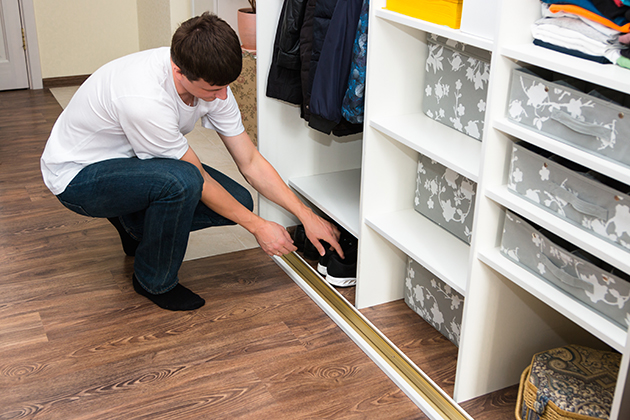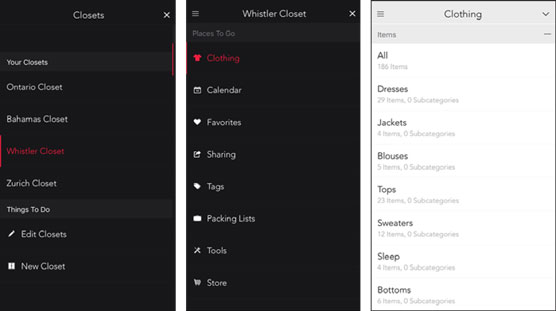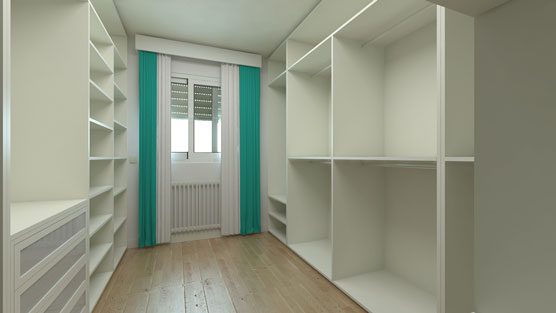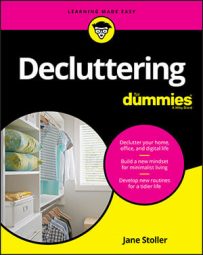On the other hand, larger closets can also be the reason you accumulate so much stuff and feel the need to fill the space. The moral of this paragraph is that closet space alone is not the reason that clutter builds up.
 © AlesiaKan / Shutterstock.com
© AlesiaKan / Shutterstock.comIf you have a small closet, don’t get discouraged, as there are plenty of ways to streamline and organize the space to make it seem bigger. The first step when maximizing your closet space is to declutter; then with a few products, installations, and decorating tips, tiny closets can be the perfect size.
Take inventory
Without knowing your inventory of closet items, it is inevitable that you will acquire more clutter or “stuff” than you need. Taking inventory of what’s currently in your closet will automatically help you declutter! Assess each piece. If it’s not even worth keeping track of, it’s not worth keeping at all.Here are a few top ways to take inventory in your closet:
- Get an app. There are tons of closet apps on the market. It may seem tedious, but trust me, it is a game changer. Not only will you have your entire closet with you when you shop, but it also makes trip planning easier, encourages you to continually declutter, and keeps you conscious of how much you are adding to your closet with every new purchase. Look at the following figure for a glimpse of the Closet+ app in action.
- Take photos. If technology is not your thing, or if you’re too scared to make the commitment to document every piece of clothing, take photos of each section of your closet. Although less detailed, photos can give an overview of what you have and can be used for basic inventory purposes.
- Make a list. Old-school methods still work. Using a notebook or an Excel spreadsheet to list your items can be helpful, but it can be a lot of work to sustain and doesn’t give you a visual overview.
- Review quarterly. I am an advocate of quarterly decluttering regardless, but if all the preceding points don’t work for your lifestyle or you aren’t ready to fully commit to an inventory tracking system, review your closet inventory quarterly and make the best mental notes possible.
 © Closet+ (closetapp.com)
© Closet+ (closetapp.com)The Closet+ app in action
Evaluate your space
While you may dream of 500-square-foot closet spaces, adding closet space is not necessarily the best approach to decluttering. Less space naturally forces you to be more conscious of what you are putting into that space. I recommend evaluating the space to make sure it fits the clothes you want to keep and that your existing clothes have a well-designed home.You want your space to reflect your needs and optimize your efficiency. Evaluate whether you need to add or change the space to make it easier to grab items, or add another section if there is not enough room.
There are no guidelines for how much closet space a person typically needs. A small New York city dwelling might have the tiniest closet space, but the person living in it might work in fashion and have more clothing needs than someone living in a larger house with less clothing needs or interests.
To properly utilize your space, you may need to create either more hanging or shelving space depending on what is needed for your items. Closet organization is a big business with do-it-yourself packages available at home improvement stores or Ikea and professional consultants and custom builders available to those with a bigger closet budget.Whichever way you go, here are some basic closet organization ideas you can apply to your situation:
Organizing a walk-in closet
Walk-in closets can vary in shape and size depending on your home’s layout. If you do have the chance to design your closet, it’s a great time to work in your specific lifestyle clothing choices and build around them. This way you will have the appropriate rods and shelves versus too much shelving, which then prompts you to buy more if the shelves look empty. Typical walk-in closet shapes are square, rectangular, and L-shaped. The following figure shows your basic rectangular walk-in closet space.The key is to design a solution around your already decluttered items that fits your current needs and lifestyle. I have seen many large walk-in closets that are clutter-free, and it usually stems from the owner doing thorough planning and also making the space part of their home — something that they are proud to show off with no fear of guests seeing a cluttered mess.
 © lrainero / Pixabay
© lrainero / PixabayA walk-in closet with custom organization
Organizing a reach-in closet
Reach-in closets (see the following figure) are typically found in smaller bedrooms and apartments. They are usually rectangular and approximately 8 feet long. They are perfect for single users, and with decluttering strategies, I have seen these closets fit most people’s needs.The key to organizing a reach-in closet is to be sure to plan for seasonality, if it applies, as sometimes modifications or extra storage space may be needed for seasonal items. Your goal with the reach-in closet is also to make it part of the home and not be afraid to open it when guests arrive. This is a sign of a peaceful and clutter-free space.
 © Jose Soriano / Unsplash
© Jose Soriano / UnsplashA reach-in closet with an organization solution added
What to hang and fold
Don’t underestimate the importance of deciding what to hang and what to fold! If you have four shelves full of folded pants, it may be time to reevaluate whether you need them all. If you have no room for your hanging blouses because your pants are taking up all the hanging space, this is another opportunity to reevaluate what to hang and fold.Keep in mind the type of clothes you own and what takes up the most space. Do most of your clothes hang or need to be folded? If you mostly wear sweaters and T-shirts, you need a lot of shelving. If you mostly wear a lot of collared blouses and dresses, you need plenty of hanging space.
I don’t want to go into details of what to hang or fold since this book is dedicated to decluttering rather than organizing. So, I suggest you declutter first and then make sure you are properly hanging and folding what is needed. Following are my guidelines to help you get started.
What to hang:
- Pants with a crease (pants without can be folded)
- Blouses made of any material (iron and button top, middle, and bottom buttons)
- Jackets
- Blazers
- Slippery silks and satins
- Clothes made of delicate fabric
- Most dresses
- Camisoles
- Sweaters
- Knitwear
- T-shirts
- Jeans
- Sweats
- Lingerie
- Special dresses (things that are heavily beaded, or dresses similar to a Herve Leger bandage dress)

